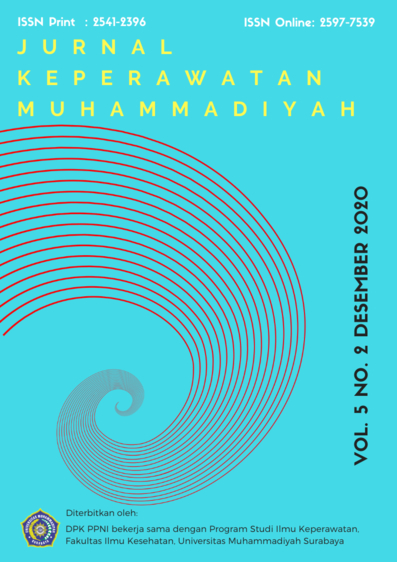Pengaruh Teknik Rebozo Terhadap Tingkat Nyeri Kala I Pada Ibu Bersalin Primipara
DOI:
https://doi.org/10.30651/jkm.v5i2.17474Keywords:
labor duration, labor pain rebozoAbstract
Objective: Labor is a natural condition that occurs in women and, in the process,
can cause severe pain, and some women can also experience excruciating pain.
Pain that maternity mothers cannot overcome can affect the mother's condition in
the form of fatigue, frustration, hopelessness, and cause stress. Stress can cause the
weakening of uterine contractions and result in prolonged labor. The Rebozo
technique is a distraction technique that poses less risk or harmful side effects than
pharmacological therapy. This study aimed to determine the effect of the rebozo
technique on the length of the first stage and the pain level during labor at Practice
Midwife Siti Nurul Aini.
Methods: This study uses a pre-experimental research design. This study consisted
of 2 groups: the treatment and control groups. The research was conducted from
November 2019 to June 2020 at Practice Midwife Siti Nurul Aini. The population
in this study were primigravida maternity mothers. The sample of this research was
selected by using the purposive sampling technique. In this study, there were 16
respondents in the intervention group and 16 in the control group. The rebozo
technique is given as long as there are contractions during the first stage of labor.
The Verbal Descriptor Scale (VDS) measures the pain level. This study used an
independent T-Test data analysis technique.
Results: Based on the independent T-test, the P-value was 0.002, and less than
0.05, Ha was accepted, so it was concluded that the rebozo technique’s effect on
the length of the first stage of labor. Statistical tests using the Independent T-test
obtained a P-value of 0.000, less than 0.05, then Ha was accepted, concluding that
the rebozo technique had affected the pain level in labor.
Conclusion: primigravida maternity who used the rebozo technique progressed
faster than the control group. Meanwhile, the pain level of primigravida mothers
who used the rebozo technique was lower than the control group. Therefore, the
rebozo technique statistically affects the length of labor and the pain level in the
first stage of labor in primiparous mothers. The results of this study can be used as
an alternative non-pharmacological method in midwifery services to overcome
labor pain.
References
Afifah, D., Budi, M., & Ninik, P. (2011). Perbedaan Tingkat Nyeri Persalinan Kala I pada Ibu Bersalin Normal Primigravida dan Multi Gravida. Jurnal Universitas Muhammadiyah Semarang, 2–7.
Anna, L. (2014). 7 Ways to Reduce Labor Pain from Around the World. https://lifestyle.kompas.com/read/2014/01/09/1725219/7 How to reduce pain, labor,%0Afrom the whole world%0D
Cunningham, F. G., Leveno, K. J., Bloom, S. L., Spong, C. Y., & Dashe, J. S. (2014). Williams obstetrics, 24e. Mcgraw-hill New York, NY, USA.
Febby. (2019). Rebozo Technique: Helping Labor More Comfortably with Cloths. https://en.theasianparent.com/teknik-rebozo-kain-jarik/? utm_ source = artic lebottom &%0Autm_medium=copy&utm_campaign=article-share
Hamdamian, S., Nazarpour, S., Simbar, M., Hajian, S., Mojab, F., & Talebi, A. (2018). Effects of aromatherapy with Rosa damascena on nulliparous women’s pain and anxiety of labor during first stage of labor. Journal of Integrative Medicine, 16(2), 120–125. https://doi.org/10.1016/j.joim.2018.02.005
Inversen. (2017). Danish Women’s Experiences of the Rebozo Technique During Labour: Qualitative Explorative Study. Sexsual Reprod Healthc., 11, 79–85.
Mander, R. (2012). Labor Pain: Suportive Care and Midwifery. EGC.
Manuaba, I. A., Manuaba, I., & Manuaba, I. B. (2010). Buku ajar penuntun kuliah ginekologi. Jakarta: Penerbit CV. Trans Ino Media.
Munafiah, D., Astuti, L. P., Parada, M. M., & Demu, M. R. M. (2020). Manfaat Teknik Rebozo Terhadap Kemajuan Persalinan. Midwifery Care Journal, 1(3), 23–27.
Mutmainnah, A. U., SiT, S., Herni Johan, S. E., SKM, M. S., Llyod, S. S., SiT, S., & Mahakam, A. K. M. (2017). Asuhan Persalinan Normal dan Bayi Baru Lahir. Penerbit Andi.
Paramita, I., Pramestyani, M., & Fitriannisa, F. (2014). Efektivitas perlakuan pijat effleurage pada kala i fase aktif persalinan untuk mengurangi rasa nyeri pada ibu bersalin di BPM yusnaeni bulan mei tahun 2013. Journal of Health (JoH), 1(1), 12–17.
Peterson, S. J., & Bredow, T. S. (2009). Middle range theories: Application to nursing research. Lippincott Williams & Wilkins.
Potter, & Perry. (2006). Fundamental Keperawatan : Konsep, Proses dan Praktik (4th ed.). EGC.
Ranjbaran, M., Khorsandi, M., Matourypour, P., & Shamsi, M. (2017). Effect of massage therapy on labor pain reduction in primiparous women: A systematic review and meta-analysis of randomized controlled clinical trials in Iran. Iranian Journal of Nursing and Midwifery Research, 22(4), 257.
Rejeki, S., Nurullita, U., & Krestanti, R. (2013). Tingkat Nyeri Pinggang Kala I Persalinan melalui Teknik Back-Effluerage dan Counter-Pressure. Jurnal Keperawatan Maternitas, 1(2).
Smith, C., Levett, K., Collins, C., Dahlen, H., Ee, C., & M, S. (2018). management in labour ( Review ). Cochrane Database of Systematic Reviews, 3. https://doi.org/10.1002/14651858.CD009290.pub3.www.cochranelibrary.com
Sumarah. (2009). Perawatan Ibu Bersalin: Asuhan Kebidanan Pada Ibu Bersalin. Salemba Medika.
Tamsuri, A. (2007). Konsep dan penatalaksanaan nyeri. Jakarta: EGC, 212.
Yuningsih, R. (2016). Pengembangan Kebijakan Profesi Bidan dalam Upaya Meningkatkan Pelayanan Kesehatan Ibu dan Anak. Aspirasi: Jurnal Masalah-Masalah Sosial, 7(1), 63–76.
Yuriati, P., & Sartika, W. (2022). MANFAAT PERSALINAN NYAMAN DENGAN TEKNIK REBOZO PADA IBU HAMIL DIWILAYAH KERJA PUSKESMAS MEKAR BARU. Jurnal Pengabdian Masyarakat Anugerah Bintan (JPMAB), 3(1).
Downloads
Published
Issue
Section
License
- Penulis tetap memegang hak atas karyanya dan memberikan hak publikasi pertama kepada jurnal ini yang secara simultan karya tersebut dilisensikan di bawah:Â Creative Commons Attribution-ShareAlike 4.0 International (CC BY-SA 4.0)













